DAWSON CITY, YUKON -— Sophie hauled her massive head out of the water and shook it. Twice. Even from a distance, I could hear the sound of her icicle-coated fur, which rang out like a glass chandelier shaking in an earthquake.
She stopped, sniffed the air briefly, and shook vigorously again — Tinkle, tinkle, tinkle!
Sophie the ice-bear — more on her later — peered once more into the water to inspect for lingering chum salmon. Finding none, she lumbered off.
I put my camera down and looked at the world through my own eyes. I was in the Bear Cave Mountain region of the northern Yukon, possibly one of the wildest and most remote spots in a country known for its wilderness.
As far as my eyes could see, spruce forests butted up against a halo of craggy mountains. The ecologically untouched river that runs through it, Fishing Branch, is home to a massive annual salmon spawning. Making the area even more special are the honeycomb of caves, used by bears and created by the river that, at one point, runs under the mountains and emerges on the other side.
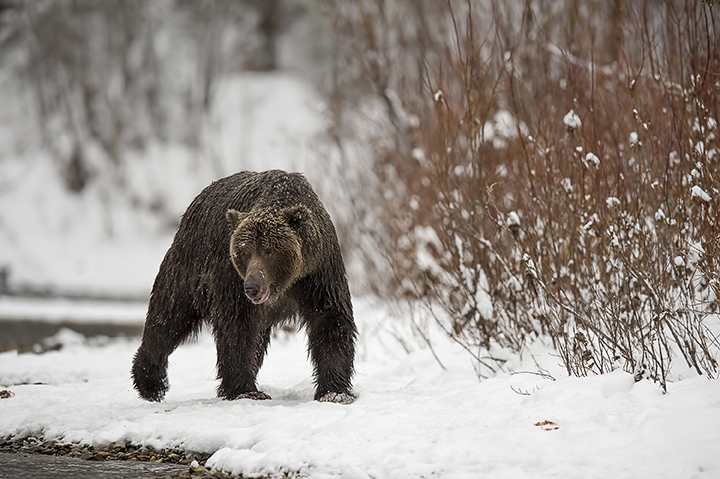
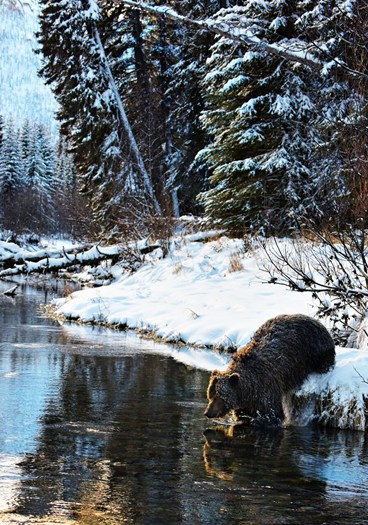
Left: Watson, another bear Michelle encountered on her trip to the Yukon, approached her with his long claws exposed while he hunted for salmon along the river. Right: Michelle patiently waited to the bears to come to the river for water.
Our journey had begun in another mythical place, Dawson City. Now just a tidy hamlet of 1,319 souls, it was founded in 1887 by Joseph Ladue and named after Canadian geologist, George M. Dawson. Once home to more than 40,000 gold-seekers in 1889, its history goes back millennia to when the Tr’ondëk Hwëch’in people held sway.
As remote as Dawson City is, it is just a stepping off point to the Yukon’s vast interior, home to just 350 humans — mostly the indigenous Vuntut Gwitchin people — who view Ni’iinlii Njik, as they call “Bear Cave Mountain,” as a sacred place. For an hour and a half, we flew by helicopter over the Dempster Highway and saw the porcupine caribou migration and what seemed like the rooftop of our country in endless mountains, rivers and trees.
Before we began our flight, I tried to explain the allure of this wild, untamed land to Julie, my friend from Ottawa.
Bear Cave Mountain, I explained, is unique in Canada, mostly because the thermal springs and porous karst rock formations of the region ensure that, despite the frigid temperatures, there is a constant flow of warm, oxygenated water through the river systems. This attracts fat chum salmon, which come from the distant Bering Strait to the region to lay eggs and die. The salmon are what attract the ice bears.
Ice bears are actually grizzlies, massive 90- to 270-kilogram creatures better known for their distinctive humped shoulder and shaggy cream, silver or black fur. In this region, however, the combination of the cold air and the warm water coat them in frost and icicles, giving them an ethereal and otherworldly air. Like Sophie, their festive decorations jingle when they move.
Charming as that sounds, they are nevertheless at the top of the food chain and fear no man. Sometimes bold, sometimes shy, they were all around us. Some days it would take minutes, others it would take hours to see any action. The habituated bears would emerge in proximity to feed on their meal. They would dive into the water and bring out their catch to eat it all within minutes.
When they did approach, it was intimidating. Our guide Phil Timpany would hold up his gun, whisper a few words and the bear would turn away. One day, Sophie stood just five feet away from us, no doubt wondering why I stood between her and the river. It was exhilarating, terrifying and completely unforgettable.
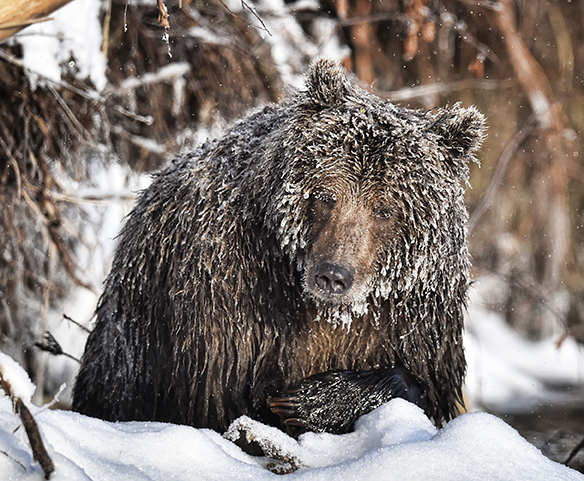
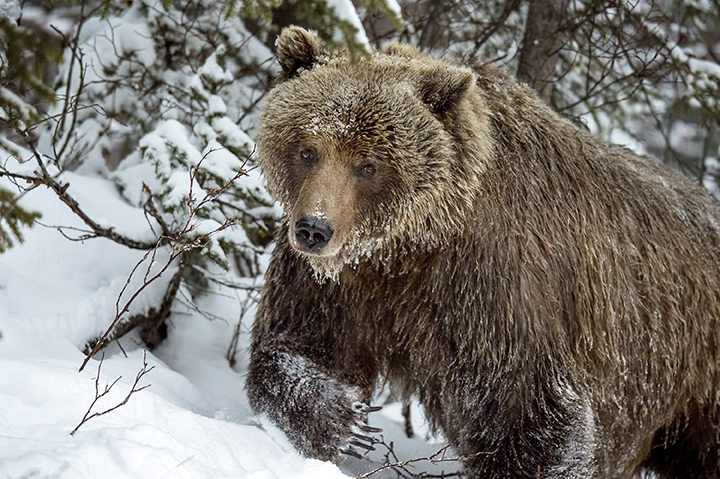
Left: Sophie tinkled when she walked because of the ice attached to her fur. Right: There is nothing more beautiful than seeing a bear in the wild.
Phil, the only tour operator allowed in the area, has named the bears to help identify them and to determine which of them would tolerate human presence and which ones should be avoided. In order to protect the region’s sanctity, only four guests are allowed at a time.
The wildlife and terrain were only part of the challenge.
The rustic, simple cabins were just that — clean and comfortable, but with no running water or power. Fortunately, Phil’s bush lore extended to creating three delicious meals daily.
Keeping warm in a rugged outdoor environment required some creative thinking and packing due to weight limits for this trip. Thanks to my Canada Goose parka, I was able to withstand long, motionless hours sitting next to a river (amidst frozen fish guts).
As many photographers know, weight restrictions are our worst nightmare. Advances in technology mean our equipment is certainly lighter than in the past, but we still require lenses, camera bodies and tripods. In this instance, I chose two cameras: a Nikon D4S and a Nikon D810. For lenses, I packed the NIKKOR 14-24mm, 80-400mm and the extraordinary 800mm lens.
The value of the 800mm lens was brought home one day when Sophie, by then a familiar face, leapt into the water directly in front of me to grab a fat salmon. For such a massive beast, she was quick and agile. In seconds, she was gone.
Still, I managed to take a photo that defined our trip: Sophie, mid-charge with a flailing salmon firmly in her jaws.
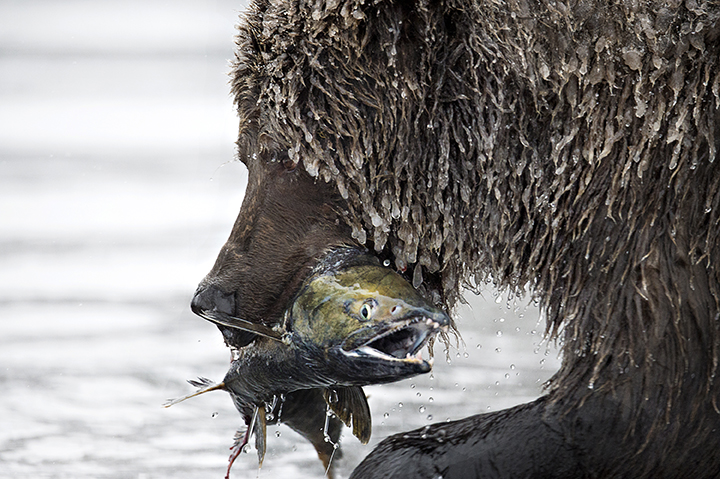
Above: Sophie quietly appeared and jumped in the water, locking the shocked salmon in her mighty jaws.
Moments later, I sat back on my heels and turned my face to the watery northern sun. I thought about Sophie and her life. About the other ice bears we’d met and how their fate is in the hands of the human guardians of this marvellous place. I thought about other environments, where animals are trapped and killed — sadly to end up as stuffed trophies in some distant hunter’s man cave.
True, I had my trophies. But I had something else, too. I had captured — in photos — the living, breathing heart of Bear Cave Mountain.
Information
Nikon Ambassadors like Michelle Valberg are some of the most talented and influential visual artists working in the business today. These gifted storytellers go above and beyond most, and are admired for their passion, energy and commitment to their craft. / Learn more about the Nikon Canada Ambassadors at
www.nikon.ca/Learn-And-Explore/Nikon-Ambassadors/index.page.'>www.nikon.ca/Learn-And-Explore/Nikon-Ambassadors/index.page. / Find Nikon Canada at
www.nikon.ca / Michelle Valberg:
www.michellevalberg.com and follow Michelle on Instagram - michellevalbergphotography